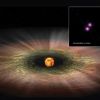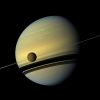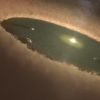Post Overview
-
Analysis
9 years ago +15 15 0
+15 15 0Dark Energy Measured with Record-Breaking Map of 1.2 Million Galaxies
A team of hundreds of physicists and astronomers, including those from Berkeley Lab, have announced results from the largest-ever, three-dimensional map of distant galaxies. The team constructed this map to make one of the most precise measurements ...
-
Analysis
9 years ago +8 8 0
+8 8 0Messier 67 Star Cluster Harbors Unusual Number of Exotic Giant Planets --"Was It Once Home to Our Sun?"
An international team of astronomers have found that there are far more planets of the hot Jupiter type than expected in a cluster of stars called Messier 67. This surprising result was obtained using a number of telescopes and instruments,...
-
Analysis
9 years ago +45 45 0 x 1
+45 45 0 x 1New Planet Is Largest Discovered That Orbits Two Suns
©Lynntte Cook If you cast your eyes toward the constellation Cygnus, you'll be looking in the direction of the largest planet yet discovered around a double-star system.
-
Analysis
9 years ago +27 27 0
+27 27 0Smaller Stars Pack Big X-ray Punch for Would-Be Planets
©NASA Young stars much less massive than the Sun can unleash a torrent of X-ray radiation that can significantly shorten the lifetime of planet-forming disks surrounding these stars.
-
Analysis
9 years ago +9 9 0
+9 9 0Galaxy Cluster Spotted in Early Universe
Astronomers discover a vast collection of young galaxies from the early universe.Astronomers have discovered a collection of young galaxies, stretching more than 489 million by 244 million light-years whose light has taken 12 billion years to reach E ...
-
Analysis
9 years ago +29 29 0
+29 29 0Fermi Helps Link Cosmic Neutrino to Blazar Blast
Nearly 10 billion years ago, the black hole at the center of a galaxy known as PKS B1424-418 produced a powerful outburst. Now astronomers using data from NASA's Fermi Gamma-ray Space Telescope and other space- and ground-based observatories hav ...
-
Analysis
9 years ago +28 28 0
+28 28 0Andromeda's first spinning neutron star
Decades of searching in the Milky Way's nearby 'twin' galaxy Andromeda have finally paid off, with the discovery of an elusive breed of stellar corpse, a neutron star, by ESA's XMM-Newton space telescope.31 March 2016
-
Analysis
9 years ago +33 33 0
+33 33 0'Cannibalism' between stars: New research shows the turbulent past of our sun
Stars are born inside a rotating cloud of interstellar gas and dust, which contracts to stellar densities thanks to its own gravity. Before finding itself on the star, however, most of the cloud lands onto a circumstellar disk forming around the star ...
0 comment(s) via phys.org -
Analysis
9 years ago +37 37 0
+37 37 0Witnessing Springtime on Titan
Cassini data spanning a decade show how Titan’s surface temperatures evolve as its seasons change.
-
Analysis
9 years ago +31 31 0
+31 31 0Mystery Cloud in the Milky Way Points to Existence of New Black Holes
A team of astronomers has found an enigmatic gas cloud, called CO-0.40-0.22, only 200 light years away from the center of the Milky Way. What makes CO-0.40-0.22 unusual is its surprisingly wide velocity dispersion: the cloud contains gas with a...
-
Analysis
10 years ago +31 31 0
+31 31 0Wisps Under the Rings
Dione's beautiful wispy terrain is brightly lit alongside Saturn's elegant rings.
-
Analysis
10 years ago +25 25 0
+25 25 0Hubble Peers Inside Exoplanets' Atmospheres - Sky & Telescope
Astronomers using Hubble and Spitzer to study hot Jupiter exoplanets revealed when and how clouds form on these alien worlds.
-
Analysis
10 years ago +44 44 0 x 1
+44 44 0 x 1Robots to Spy On Black Holes
Astronomers wanting more accurate measurements of distant black holes have some new assistants — robots that can tackle the tedious task of monitoring black hole neighbor clouds’ glow.
-
Analysis
10 years ago +32 32 0
+32 32 0Birth of Planets! Formation of Alien Worlds Photographed for 1st Time
Scientists have photographed a gas-giant planet forming around a young, sunlike star called LkCa 15, which lies about 450 light-years from Earth.
-
Analysis
10 years ago +31 31 0
+31 31 0Clue to Formation of Magnetic Fields Around Stars and Galaxies
An enduring astronomical mystery is how stars and galaxies acquire their magnetic fields. Physicists Jonathan Squire and Amitava Bhattacharjee at the U.S. Department of Energy's Princeton Plasma Physics Laboratory have found a clue to the answer ...
-
Analysis
10 years ago +30 30 0
+30 30 0NASA’s Swift spots its thousandth gamma-ray burst
NASA’s Swift spacecraft has detected its 1,000th gamma-ray burst (GRB). GRBs are the most powerful explosions in the universe, typically associated with the collapse of a massive star and the birth of a black hole.
-
Analysis
10 years ago +24 24 0
+24 24 0IBEX Sheds New Light on Solar System Boundary
In 14 papers published in the October 2015 Astrophysical Journal Supplement, scientists present findings from NASA’s Interstellar Boundary Explorer, or IBEX, mission providing the most definitive analyses, theories, and results about local interstell ...
-
Analysis
10 years ago +24 24 0
+24 24 0Astronomers "Weigh" a Galaxy's Black Hole by Studying the Einstein Ring Phenomenon
Astronomers at the Institute of Astronomy and Astrophysics (ASIAA), Postdoctoral Fellow Dr. Kenneth Wong, Assistant Research Fellow Dr. Sherry Suyu and Associate Research Fellow Dr. Satoki Matsushita have recently analyzed the highest-ever resolutio ...
-
Analysis
10 years ago +28 28 0
+28 28 0Dwarf planet Ceres – new name, new maps, new questions
This week, scientists at the European Planetary Science Conference (EPSC) in Nantes, France are busy with the mysterious crater structures and fascinating views of the multifaceted dwarf planet Ceres. The German Aerospace Center (Deutsches Zentrum fü ...
-
Video/Audio
10 years ago +22 22 0
+22 22 01/10/2015| Pluto Out of the Darkness
1/10/2015| Pluto Out of the Darkness from Richard Pearson PLUS 4 days ago / Creative Commons License: by nc ALL AUDIENCES Running Time: 33 minutes In this month's program we take a detailed look at the planet Pluto at the edge of our solar sy ...




















